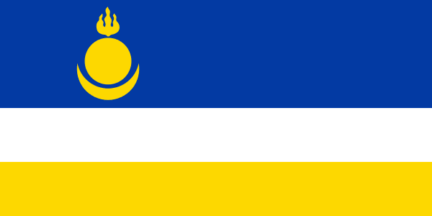Buryatia (Russia) (original) (raw)

This page is part of © FOTW Flags Of The World website
Burâtiâ
Last modified: 2020-02-24 by rob raeside
Keywords: buryatia |
Links: FOTW homepage |search | disclaimer and copyright | write us | mirrors
Бурятия
 image by Tomislav �ipek, 19 December 2019
image by Tomislav �ipek, 19 December 2019
- Presentation of Buryatia
- Description and meaning of the flag
- Unknown Buryatian (?) flag spotted in Spain See also:
- Buryatia in the Soviet Union, 1923-1992
- Russia
- Aginsky Buryatia
- Ust-Ord Buryatia
- Ulan-Ude
- Russian subnational flags (overview of the subdivisions, list of federation “subjects” and clickable map)
- Siberia External links:
- Государственная символика, the official republic website, with short description of the arms and flag with small depictions. Also in English
reported by Jorge Candeias and António Martins, 22 Dec 2000 - Arms of Ulan-Ude, capital of Buryatia, at the official city website
reported by István Molnár, 04 Dec 2001
Presentation of Buriatia
(Note: You need an Unicode-aware software and font to correctly view the Cyrillic text on this page. See here transliteration details).
- Name (English): Buriatia • (Russian, short form): Бурятия | Burâtiâ • (Russian, long form): Республика Бурятия | Respublika Burâtiâ
- Local official language: Buryat
- Capital: Улан-Уде | Ulan-Ude • (former name): Udisnk | Удинск (1666-1783), Verqneudinsk | Верхнеудинск (1783-1934)
- Area: 351 300 km2 (~135 600 sq.mi.) • Population: 1 029 200 inhabitants in 2000
- Status: Republic (Республика | Respublika) within the Russian Federation
- Federal District: Siberia • Economic region: East Siberia
- License plate code: 03 • Ham radio code: BU • ISO 3166-2 code: BU
- Flag adopted on 1992.10.29 • Coat of arms adopted on 1995.04.20
Buryat people live in Siberia, near Mongolia; they are Buddhist, like Kalmykian.
Giuseppe Bottasini
Description and meaning of the flag
On 29 October 1992 they adopted a State flag, a 2:1:1 light blue [see bellow!] - white - yellow horizontal stripped one. At 1/4 from the left border there is a yellow Mongol device composed of the same objects (the fire, the sun, the moon) that are on the top of the_Soyombo_, the symbol of Mongol Republic. The Soyombo (a Sanskrit-derived word meaning "a self-explaining writing") was in origin an end-mark for lamaistic writings of XVII century. It became very popular. The three objects represent three of the four cosmological elements (the fire for heavens or ether, the sun, the moon for the air) and they are also present in Indian_stupa_.
Giuseppe Bottasini, quoting [zig94]
Whether the distance between the soyonbo and the staff (1/4th) refers to the centre of the emblem, or to its inner or outer edge is unclear from the legal text.
Christopher Southworth, 09 Oct 2003
The flag of Buryatia is medium blue (matching theRussian national flag’s shade) not only in practice but also by law. The only source giving this flag as light blue is [zig94], which, considering its publishing date, might very well be wrong or referring to an earlier flag or flag project. Trusting the book _Winds of Change_[rss96], the original flag law of 1992.10.29 stated already siniĭ (medium blue), and never a lighter shade.
António Martins, 10 May 2000
All these three flags, Mongolia’s, Buryatia’s and Agin Buryatia’s) show soyonboes.
António Martins, 05 Sep 2000
This flag, in medium blue, is listed under number 123 at the chart_Flags of Aspirant Peoples_ [eba94] as: «Buryat Ulus [Buryatia] (Buryat Mongols) - South Siberia».
Ivan Sache, 15 Sep 1999
Law text
Here is the relevant text of Law No. 268-XII of the Supreme Soviet of the Republic of Buryatia dated 29 October 1992, with flag usage being slightly amended by Law No. 348-XII of 3 June 1993. Article One (from Winds of Change [r4f96], supplied by Jos Poels and transcribed by myself) reads as follows:
The National flag of Buryatia is a rectangular panel consisting of three horizontal stripes: the upper stripe is blue and occupies one-half the width (of the flag); the middle stripe is white and occupies one-fourth, and the lower stripe is yellow and occupies (the remaining) one fourth of the width of the flag.
In the left upper corner of the blue part of the flag, at the distance of one-fourth of flag length from the staff, is a traditional symbol of Buryatia (soyonbo) depicted in yellow. This symbol is an image of the moon, the sun and a hearth in the following order: at the bottom appears a crescent moon, with the sun above it, and an image of a hearth, from which rise three tongues of flame, above both.
The ratio of the flag width to its length is 1:2.
Christopher Southworth, 09 Oct 2003
Unknown Buryatian (?) flag spotted in Spain
Some kind of music or theater festival was taking place at Sóller, whereby a weird assortment of flags was displayed in front of the city hall. I can remember a horizontal blue-white-light green flag with an orange device on the canton, identical in position, shape and size to that on theAghin Buriatia flag. This flag appeared to be also a sinister hoist version, with no device on the obverse — this image shows thereverse of the flag I actually saw. The obverse had no canton device. This flag I saw might be a (very) mistaken version of the Buryatia flag.
Santiago Dotor, 06 Sep 2000